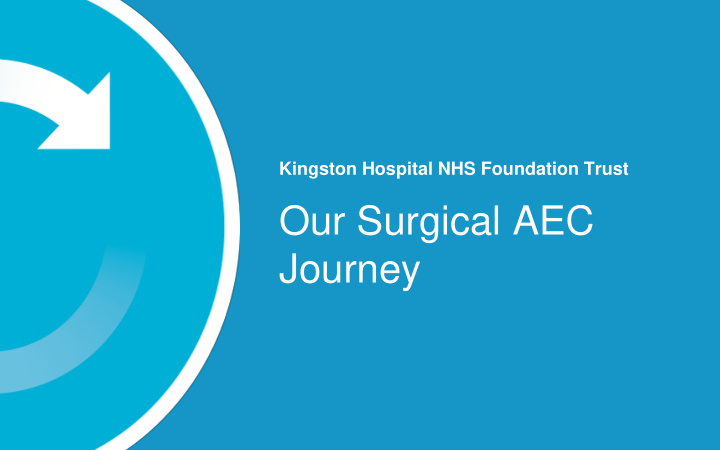



Kingston Hospital NHS Foundation Trust Our Surgical AEC Journey
Background • There was no provision for surgical patients who needed urgent/emergency investigations, but were well enough to go home. • Admission for 24-hr observation (Std. practice) • Well-established medical AEC
Changes/Improvements • SAEC established with the following inclusion criteria: ➢ Not diabetic ➢ Not septic ➢ Over 18 years old ➢ Right iliac fossa or right upper quadrant pain • Patient presents at 8 am, has blood tests. At 9am, has CT/Ultrasound. • Patient reviewed by Surgical Registrar following these investigations • Well-established abscess pathway further improved
Measurement/Impact of Changes Opening of hot • Average adult surgical take = 8.5 clinics patients Existing abscess Around 20-25% pathway • 20-25% on ambulatory pathway on ambulatory pathway since January 2018 • No evidence that patients previously turned around by A&E now on pathway • Too early to gauge impact on LoS (impact of acuity and holiday periods during Dec / Jan)
Challenges • Patient information leaflets are not always given to patients (SHOs not giving out) • Communication with SAEC Nurse • Patients seen by the surgical team in ED before sent to SAEC. • Lack of space in which to see patients • Inability to administer IV therapies within the existing ambulatory unit • Winter pressures, lack of hospital beds • Governance around inclusion criteria
Next Steps • Relocation of SAEC to a more suitable environment • Allow direct referral from ED/GP directly to the SAEC • Ensure SHOs/A&E giving out SAEC patient information leaflet • Expand inclusion criteria • Electronic booking system
Barriers to be overcome • Staffing identified area in Emergency Department with nursing staff • Addressing perceptions of colleagues about ability to ED staff to make appropriate referrals into SAEC without surgical assesssment in ED • Coding and billing for SAEC attendances
Actions to overcome barriers • Approach Emergency Care Programme Board to assist with improving emergency surgical assessment and care provided through organizational support to ensure staffing and space for SAEC and SAU • Meeting the BI to find solutions for coding of patient encounters and meet with commissioners if required • More collaboration with Emergency Department team to ensure appropriate quality of referrals and develop partnerships for delivering care
Recommend
More recommend